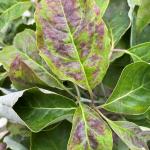UMass Extension's Landscape Message is an educational newsletter intended to inform and guide Massachusetts Green Industry professionals in the management of our collective landscape. Detailed reports from scouts and Extension specialists on growing conditions, pest activity, and cultural practices for the management of woody ornamentals, trees, and turf are regular features. The following issue has been updated to provide timely management information and the latest regional news and environmental data.
The Landscape Message will be updated bi-monthly in July. The next message will be posted on August 6. To receive immediate notification when the next Landscape Message update is posted, be sure to join our e-mail list
To read individual sections of the message, click on the section headings below to expand the content:
Scouting Information by Region
Environmental Data
The following data was collected on or about July 21, 2021. Total accumulated growing degree days (GDD) represent the heating units above a 50° F baseline temperature collected via regional NEWA stations for the 2021 calendar year. This information is intended for use as a guide for monitoring the developmental stages of pests in your location and planning management strategies accordingly.
|
MA Region/Location |
GDD |
Soil Temp |
Precipitation |
Time/Date of Readings |
||
|
2-Week Gain |
2021 Total |
Sun |
Shade |
|||
|
CAPE |
315.5 |
1293.5 |
75 |
71 |
0.83 |
12:00 PM 7/21 |
|
SOUTHEAST |
323.5 |
1365 |
85 |
75 |
2.75 |
3:00 PM 7/21 |
|
NORTH SHORE |
285.5 |
1432.5 |
70 |
66 |
3.91 |
10:00 AM 7/21 |
|
EAST |
289 |
1445 |
78 |
73 |
4.58 |
5:00 PM 7/21 |
|
METRO |
285 |
1362.5 |
68 |
66 |
5.39 |
6:00 AM 7/21 |
|
CENTRAL |
296.5 |
1406 |
68 |
66 |
7.18 |
7:00 AM 7/21 |
|
PIONEER VALLEY |
308.5 |
1425 |
77 |
70 |
7.60 |
12:30 PM 7/21 |
|
BERKSHIRES |
277.5 |
1170 |
74 |
68 |
8.71 |
7:30 AM 7/21 |
|
AVERAGE |
298 |
1362 |
74 |
69 |
5.12 |
_ |
|
n/a = information not available |
||||||
As of 7/20, there is a "moderate drought" status for the mid Cape and "abnormally dry" conditions for the upper and lower Cape and Nantucket: https://droughtmonitor.unl.edu/CurrentMap/StateDroughtMonitor.aspx?MA
Municipal water restrictions map dated 7/9: https://www.mass.gov/doc/water-use-restrictions-map/download
Phenology
| Indicator Plants - Stages of Flowering (BEGIN, BEGIN/FULL, FULL, FULL/END, END) | ||||||||
|---|---|---|---|---|---|---|---|---|
| PLANT NAME (Botanic / Common) | CAPE | S.E. | N.S. | EAST | METRO W. | CENT. | P.V. | BERK. |
|
Clethra alnifolia (summersweet clethra) |
Begin |
Begin |
* |
Begin |
Begin |
Begin |
Begin |
* |
|
Hydrangea paniculata (panicle hydrangea) |
Begin/Full |
Begin |
Begin |
Begin |
Begin/Full |
Begin/Full |
Begin/Full |
Begin |
|
Hibiscus syriacus (rose-of-Sharon) |
Begin |
Full |
Full |
Begin/Full |
Begin/Full |
Begin/Full |
Begin/Full |
Begin |
|
Lythrum salicaria (purple loosestrife) |
Full |
Full/End |
Begin/Full |
Full |
Begin/Full |
Full |
Full |
Begin/Full |
|
Oxydendrum arboreum (sourwood) |
Begin/Full |
Full |
Full |
Begin/Full |
Full |
Full |
Begin/Full |
* |
|
Buddleia davidii (butterfly bush) |
Full |
Full |
Full |
Full |
Full |
Full |
Full |
Begin/Full |
|
Campsis radicans (trumpet vine) |
Full |
Full/End |
Full/End |
Full |
Full |
Full |
Full |
Full |
|
Hydrangea macrophylla (bigleaf hydrangea) |
Full/End |
Full |
Full |
Full |
Full/End |
Full |
Full/End |
Full |
|
Koelreuteria paniculata (goldenrain tree) |
Full |
* |
Full/End |
Full |
Full/End |
Full/End |
Full/End |
Full |
|
Rhus typhina (staghorn sumac) |
End |
Full/End |
Full/End |
Full/End |
Full/End |
Full/End |
End |
Full/End |
| * = no activity to report/information not available | ||||||||
Regional Notes
Cape Cod Region (Barnstable)
General Conditions: The average temperature for the period from July 7 thru July 21 was 72˚F with a high of 89˚F on July 7 and a low of 56˚F on July 11. The last week or so has been dominated by days in the 80s with lows in the 60s/70s. The period from July 1 – July 14 was incredibly sunless for this time of year, recording only a single truly sunny day during that stretch. During the current two-week period, less than an inch of precipitation fell, most of it being split between showers on July 9 and July 12. The rain that most of Massachusetts received seemed to have avoided the Cape. Soil moisture remains short and the US Drought monitor has determined the Cape’s status between abnormally dry and moderate drought for the last several weeks. Woody plants seen in bloom during the period include stewartia, Japanese spiraea, New Jersey tea, privet, St. John’s wort, roses, rose of Sharon, mimosa, sourwood, and oakleaf, smooth, panicle and bigleaf hydrangeas. Herbaceous plants in bloom include daylily, Asiatic lily, astilbe, liatris, echinacea, shasta daisy, oxeye daisy, coreopsis, lavender, hosta, catmint, crocosmia, Salvia yangii (previously known as Perovskia atriplicifolia, commonly called Russian sage), creeping bellflower, achillea, butterfly weed, Baptisia tinctorial (yellow wild indigo), Veronicastrum virginicum (Culver’s root), black eyed Susan, balloon flower, and cutleaf coneflower.
Pests/Problems: Insect pests or damage seen during the last two weeks include Japanese, Oriental, and Asiatic beetles, daylily leaf miner on daylily, winged euonymus scale on winged euonymus, white prunicola scale on lilac, black turpentine beetle on pitch pine, pine tip moth on pitch pine, hibiscus sawfly on hardy hibiscus, witchhazel cone gall on witchhazel, azalea lacebug on azalea, andromeda lacebug on andromeda, sassafras weevil damage on sassafras, and shothole leafminer damage on white oak. After several seasons of high lecanium scale populations it is now difficult to find in the areas I have scouted. Plant disease symptoms or signs observed during the period include maple anthracnose, blackspot on rose, leaf spot on river birch, apple scab and cedar-apple rust on crabapple, cercospora leaf spot on hydrangea, powdery mildew on smokebush, needlecast on pitch pine and red thread on turf. The following weeds and wildflowers were seen in bloom: sheep’s bit (Jasione montana), spotted knapweed, rabbitfoot clover, chicory, carpetweed, prostrate spurge, Pennsylvania smartweed, annual fleabane, pokeweed, white clover, bird’s-foot trefoil, yellow toadflax, Queen Annes’ lace, and narrowleaf plantain. Don’t forget to protect yourself from mosquitoes and ticks. Rabbits continue to be a problem in most landscapes.
Southeast Region (Dighton)
General Conditions: Tropical weather has predominated with heat, high humidity, rain and violent thunderstorms. There has been localized flooding. The water table is high, with ponds, rivers and streams noticeably full. Except for storm damage, growing conditions have been good. Unirrigated lawns are still green. Weeds are coming on strong with warm weather and adequate moisure. Yellow nutsedge is obvious in turf although not yet flowering and crabgrass has five or more leaves but no tillers. Monarch butterflies have arrived. Great golden sand diggers (Sphex ichneumoneus) and blue mud daubers (Chalybion californicum) can be seen competing with honey bees, carpenter bees and hummingbird moths for nectar. Among the many plants now flowering, I've noticed: Albizia julibrissin (mimosa, silktree), Campanula rapunculoides (creeping bellflower), Asclepias incarnata (swamp milkweed), A. syrica (common milkweed), Vernonia noveboracensis (New York ironweed), Buddleja davidii (butterfly bush), Daucus carota (Queen Anne's lace), Campsis radicans (trumpet vine), Clethra alnifolia (summersweet), Echinacea purpurea (coneflower), Eutrochium purpureum (Joe-pye-weed), Hemerocallis (daylily), Hibiscus syriacus (rose of Sharon), Hosta spp. (plantain lilies), Hydrangea macrophylla (bigleaf hydrangea), H. paniculata (panicled hydrangea), Leucanthemum x superbum (shasta daisy), Liatris spicata (blazing star), Lilium lancifolium (tiger lily), Linaria vulgaris (toadflax), Lotus corniculatus (bird’sfoot trefoil), Lysimachia ciliata (fringed loosestrife), L. clethroides (gooseneck loosestrife), Lythrum salicaria (purple loosestrife), Monarda didyma (scarlet beebalm), Oenothera biennis (common evening primrose), Oxydendrum arboreum (sourwood), Phlox paniculata (garden phlox), Rhus typhina (staghorn sumac), Rudbeckia hirta, (black-eyed Susan), Salvia yangii (previously known as Perovskia atriplicifolia, commonly called Russian sage), Solidago juncea (early goldenrod), Spiraea alba (meadowsweet), Tanacetum vulgare (tansy), Verbascum thapsus (great or common mullein), Vicia villosa (hairy vetch), and Vitex agnus-castus (chaste tree).
Pests/Problems: Japanese, Oriental, and Asiatic garden beetle adults are active. Earwig damage is common on flowers such as echinacea. I have seen several male Lymantria dispar (the moth formerly known as gypsy moth) flying in their mad-dash-at-waist-level search pattern, in quest of female pheromone over the past few weeks. Given reports of defoliation level populations to the west, I suppose it's not surprising that some caterpillars have remained in our area. Still, it was disturbing to see them.
North Shore (Beverly)
General Conditions: This two-week reporting period was mostly cloudy with rain showers occurring on most days. Approximately 3.91 inches of rainfall were recorded at Long Hill during this period. Most of the rain fell on July 9. The rain showers in the last few weeks have helped to move the region out of drought. Air temperature during this period was quite variable, ranging from low 60s to low 90s. The average daily temperature was 70℉. The average daily maximum temperature was 77°F and the daily minimum temperature was 64℉ with the maximum temperature of 93℉ recorded on July 16 and the minimum temperature of 56℉ recorded on July 11. Woody plants seen in bloom include: mimosa (Albizia julibrissin), oakleaf hydrangea (Hydrangea quercifolia), smooth leaf hydrangea (Hydrangea arborescens), summer blooming spirea (Spiraea japonica), false spirea tree (Sorbaria arborea), mountain stewartia (Stewartia ovata), panicle hydrangea (Hydrangea paniculata), Chinese chaste tree (Vitex negundo), golden rain tree (Koelreuteria paniculata), sourwood (Oxydendrum arboreum), butterfly bush (Buddleia davidii) and Daphne sp. Herbaceous plants seen in bloom include: black-eyed Susan (Rudbeckia hirta), purple coneflower (Echinacea purpurea), bush cinquefoil (Potentilla fruticans), cranesbill (Geranium spp.), milkweed (Asclepias spp.), montbretia (Crocosmia spp.), shasta daisy (Leucanthemum x superbum), yarrow (Achillea millefolium), garden phlox (Phlox paniculata), hostas (Hosta spp.), sedums (Sedum spp.), lamb’s ears (Stachys byzantina), meadow rue (Thalictrum rochebrunianum), false goat’s beard (Astilbe spp.), summer flowering roses (Rosa spp.), clematis vine (Clematis paniculata), spiderwort (Tradescantia spp.), white fleece flower (Persicaria polymorpha), water lily (Nymphaea odorata) and an assortment of annuals.
Pests/Problems: Powdery mildew was observed on susceptible lilac varieties and on mountain mint (Pycnanthemum muticum). Japanese beetles were causing damage to some plants. Scales were noted on silverbell (Halesia carolina) and on the bark of a magnolia. Crabgrass, yellow sedge and other weeds are thriving due to warm temperatures and recent precipitation. Deer browsing damage was observed on some perennials and shrubs. Rabbits are plentiful this year and causing damage to some perennial and vegetable plants. Ticks and mosquitos are very active. Protect yourself with effective insect repellent before going out to the woods and check your body for ticks after you return.
East Region (Boston)
General Conditions: We received 4.58 inches of precipitation over the past two weeks, 2.56 inches of which fell from July 8 through the 10th as remnants of Tropical Storm Elsa passed through. As of July 20, we have accumulated 9.79 inches of rain so far this month with measurable precipitation falling on all but three days. Many plants are in bloom such as Actea spp. (bugbane), Albizzia julibrizzen (mimosa), Salvia yangii (previously known as Perovskia atriplicifolia, commonly called Russian sage) and Stewartia pseudocamelia (Japanese stewartia). Monarch butterflies have been visiting perennial borders.
Pests/Problems: Damp is the best way to describe the past two weeks. Fungal pathogens are thriving. Powdery mildew is prevalent throughout the landscape. Black spot is visible on rose foliage. Cedar apple rust is visible on amelanchier. Japanese beetles are feeding on foliage and slugs are thriving in the constantly moist conditions.
Metro West (Acton)
General Conditions: July has been all about the rain! The historical monthly average rainfall for the month of July is 4.07” and as of the 20th, 8.47” of rain has been recorded for this month so far, with some amount of precipitation recorded everyday this month so far except for two days, July 15th and 20th. Observed in some stage of bloom these past two weeks were the following woody plants: Albizia julibrissin (silk tree), Buddleia spp. (butterfly-bush), Clethra alnifolia (summersweet), Hibiscus syriacus (rose-of-Sharon), Hydrangea arborescens (smooth hydrangea), H. paniculata (panicle hydrangea), H. quercifolia (oakleaf hydrangea), Oxydendron arboreum (sourwood), Potentilla fruiticosa (shrubby cinquefoil), R. 'Knockout' (knockout family of roses), Rosa rugosa (beach rose), Rosa spp. (rose), Spiraea japonica 'Alpina' (daphne spirea),and Stewartia psuedocamellia (Japanese stewartia). Woody vines observed in bloom include Campsis radicans (trumpet vine) and Clematis spp. (clematis). Contributing even more color and interest to the landscape are some flowering herbaceous plants including: Actaea matsumurae 'White Pearl' (bugbane), Alcea rosea (hollyhock), Achillea millefolium (yarrow), Asclepias syriaca (common milkweed), A. tuberosa (butterfly weed), Astilbe spp. (false spirea), Campanula takesimana ‘Elizabeth’ (bell flower), Cichorium intybus (chicory), Coreopsis spp. (tickseed), C. verticillata (threadleaf coreopsis), Daucus carota (Queen Anne's lace), Echinacea purpurea (coneflower), Eutrochium purpureum (Joe Pye weed), Filipendula spp. (meadow sweet), Gaillardia aristata (blanket flower), Geranium sanguineum (bloody cranesbill), Hemerocallis fulva (orange daylily), H. 'Stella D'Oro', (daylily), H. spp. (daylily), Heuchera spp. (coral bells), Hosta spp. (plantain lily), Lamium maculatum (dead nettle), Leucanthemum sp. (shasta daisy), Lilium spp. (lily), Lychnis coronaria (rose campion), Lysimachia clethroides (gooseneck loosestrife), Monarda didyma (beebalm), Nepeta spp. (ornamental catmint), Oenothera macrocarpa (Ozark sundrops), Patrinia gibbosa (patrinia), Salvia yangii (previously known as Perovskia atriplicifolia, commonly called Russian sage), Phlox carolina (Carolina phlox), P. paniculata (garden phlox), Platycodon grandiflorus (balloon flower), Rudbeckia fulgida var. sullivantii 'Goldsturm' (black-eyed Susan), Rudbeckia hirta (black-eyed Susan), Stachys byzantina (lamb’s ears), Thymus praecox (thyme), Tradescantia spp. (spiderwort), Veronicastrum virginicum (Culver’s root), and Yucca filamentosa (yucca, Adam’s needle).
Pests/Problems: I reported above in the general conditions for this area that much is in bloom. This includes several of our aggressive weeds including Phytolacca americana (common pokeweed) and Lythrum salicaria (purple loosestrife). Setting seed and quite visible is Ailanthus altissima (tree of heaven), an invasive tree that is now highly visible and showy because its seeds (samaras) are reddish in color, are plentiful and grow in large clusters. Look for it growing along roadsides and in parking lots and medians. Observed in the landscape these past two weeks were Cedar Apple Rust on Amelanchier sp. (serviceberry), as well as deer, mosquitoes, and ticks actively feeding.
Central Region (Boylston)
General Conditions: Generally, we are fortunate most years to receive any rainfall in July. Average rainfall for the month in the Central Region is about 3.5 inches. Over the past several years, we’ve been lucky to register any measurable July precipitation. This year, we’ve recorded 10.5 inches this month so far, with the chance for more precipitation in the short-term forecast. While the abundant precipitation has almost eliminated the need for irrigation this month, it has led to problems with root rot in newly planted annuals and other ornamental landscape plants. Soils are waterlogged and new plantings are suffering from lack of oxygen. Aside from the difficulty establishing new plants in the garden, the rainfall has left many garden plants lush and beautiful. Normally, unirrigated lawns would begin to brown out and slow down in the heat, but this year most lawns are growing fast and furiously. In addition to daylilies being at their peak, there is plenty in bloom throughout the garden; this is the time of year when shrubs that bloom on this year’s growth are at their peak - summer-blooming shrubs like Hydrangea paniculata (panicle hydrangea). While many of our native woodland species have long since ended their spring blooming season, several interesting little plants have been spotted in bloom recently. These include Chimaphila maculata (spotted wintergreen), a small evergreen subshrub in the heath and heather family, and Goodyera pubescens (downy rattlesnake plantain), a small terrestrial orchid with evergreen foliage that hugs the ground and features a dizzying network of pale green to white venation.
Pests/Problems: Other than root rot associated with too much water on newly planted ornamentals, there is surprisingly little disease pressure in the garden. We’ve seen very little powdery mildew, for example. As for pests, slugs and snails are abundant.
Pioneer Valley Region (Amherst)
General Conditions: We’re rounding into the last days of July in the Pioneer Valley and it’s been a history-making month. July of 2021 will be long remembered for the unending barrage of showers and powerful thunderstorms along with persistent high humidity. While high temperatures over this past reporting period have ranged from mild to hot (71–92°F), the humidity has remained at uncomfortable to oppressive levels. There have been only two clear, sunny days all month (7/8 and 7/15), which is a stark departure from our normal conditions in mid-summer. Even though precipitation totals vary across the tri-counties, in some cases significantly, it’s been extremely wet everywhere. The Easthampton gauge has recorded 10.19” since 7/1, with measurable precipitation recorded on 17 out of 21 days this month (at the time of writing on 7/21). Some locations have recorded several inches more. This is certain to be the wettest July since record keeping began in 1895. According to the National Centers for Environmental Information (a division of NOAA), 1938 currently holds the record for wettest July with a statewide average of 8.96” (https://www.ncdc.noaa.gov/cag/statewide/rankings/19/pcp/193807). After learning that July of 1938 was the wettest on record, I assumed it was the month that the ’38 hurricane blasted southern New England. However, it wasn’t. The ’38 hurricane, once considered one of the most destructive storms in U.S. history, took place just a short time later on 9/21/38. Interestingly, the 2nd wettest July on record occurred in 2009 (8.58”), and set off an outbreak of late blight (Phytophthora infestans) on potatoes and tomatoes throughout the northeast that lasted several years. The last round of heavy rainfall, which occurred over two storms from 7/17–7/19, resulted in stream/river flooding, road washouts and residential flooding damage throughout the state. On the positive side, forests and landscapes are lush right now from the rainfall and new growth is continuing on eastern hemlock, false-cypress, arborvitae, crabapple, red maple, pin oak, and American elm, among many other landscape trees and shrubs. For trees battered by drought and insect/disease problems, this deep watering will hopefully help them to restore vigor. However, there are also signs that plants are in need of some drier weather, in the form of chlorotic foliage. While the hot temperatures are helping plants move this water through transpirational water loss, the lack of direct sunlight is slowing the process. This creates concern over waterlogged root systems in poorly drained soils. Even relatively short periods of waterlogging (i.e. 24 hours) can cause irreversible root damage and subsequent canopy dieback. Overall, soils are warm and wet right now and there has been no need to provide supplemental irrigation.
Pests/Problems: Cases of edema will likely increase on susceptible plants, such as yew, boxwood and rhododendron, as a result of the record rainfall. Maple anthracnose continues to be a problem for sugar, red, and Japanese maples. Blighted margins on Japanese maples are starting to dry and curl with some premature leaf shedding. Powdery mildew on Japanese maples, along with many other landscape plants, is also a problem this year. Shaded crabapples are losing significant amounts of foliage at this time due to apple scab. Stem and branch cankering from various opportunistic pathogens (primarily Phomopsis and Botryosphaeria) is very abundant right now. Flagging on weakened oaks is likely due to Diplodia corticola, which seems particularly adept at attacking stressed trees. Jumping oak gall wasp infestations on white oak and subsequent anthracnose development also continues to appear. The northern tooth fungus, Climacodon septentrionalis, is starting to fruit on infected sugar maples. This common trunk rot pathogen produces cream-colored, annual fruiting bodies that can develop in overlapping layers from infected trees. An array of mycorrhizal fungi continue to produce mushrooms in forest and landscape settings. They can be confused as pathogens without proper identification. The heavy rains were likely helpful in washing spider mites out of infested tree/shrub canopies. Spider mites thrive during dry periods and are easily dislodged by a strong stream of water. Mosquito populations are very high right now and will likely remain so for several weeks. Oriental beetle populations increased since our last report but don’t appear to be as abundant as last year. The (giant) green June beetle (Cotinis nitida) has been observed as well. It’s more likely these pests will be heard before they are seen as their flying generates a loud and unique buzzing sound. Terminating these pests by hand is a bit daunting, but possible with commitment. If you suspect scarab beetle feeding on woody and non-woody plants but find no evidence of the beetles, it may be the Asiatic garden beetle (Maladera castanea). Gently excavating the soil around the base of the plant can yield large numbers (upwards of 20–25) of these maroon-colored, invasive pests in a small area. They feed at night and then conceal themselves during the day in the soil at the base of the plant.
Berkshire Region (Great Barrington)
General Conditions: July 2021 looks to be setting a record for most rainfall ever for the month. Here in West Stockbridge, rain has fallen in 12 of the last 14 days, i.e. July 7-20. Soils are saturated, and in some locations, there has been considerable soil erosion. Where soil has been tilled and where there is bare soil in low spots, a fine, shiny layer of clay sits atop the soil. These clay patches should be broken up and mixed in with the soil below. Otherwise, the clay will harden to an impervious layer. Though there has been little apparent effect of the continuous deluge of the past three weeks on landscape plants, there is the potential for root injury and decline in plant growth. Much of this is due to the lack of oxygen in the soil pores. One apparent consequence of the constant rain has been the leaching of nutrients, notably nitrogen. Yellowing of plant foliage is an indication of nitrogen deficiency. Rainfall in North Adams for the scouting period amounted to 7.75 inches. Since a lightning strike took out the weather station for several days at the Pittsfield Airport, the data from there is incomplete. Except for daily highs in the mid-80s on the days of July 14 and 15, daytime temperatures have ranged from the upper 60s to upper 70s for the most part. Night time temperatures have been consistently in the 60s. Despite relatively mild temperatures, humidity levels have been very high, making outdoor work rather uncomfortable.
Pests/Problems: The most troublesome pests in landscapes and gardens now are slugs and Japanese beetles. The beetles have been especially abundant. Of great concern has been the observation that the beetles have been feeding on the new leaves of woody plants previously denuded by Lymantria dispar. If these plants are to remain healthy or even survive, the beetles must be brought under control. Speaking (writing?) of Lymantria dispar, the male adult moths are now flying around in great numbers and are mating with the non-flying females. The females are now laying their eggs which appear as tear-dropped shaped patches, often on the bark at the base of trees. With the incessant rain, plant diseases are rapidly becoming more apparent. Leaf spots and powdery mildew are seemingly the most common of diseases.
Regional Scouting Credits
- CAPE COD REGION - Russell Norton, Horticulture and Agriculture Educator with Cape Cod Cooperative Extension, reporting from Barnstable.
- SOUTHEAST REGION - Brian McMahon, Arborist, reporting from the Dighton area.
- NORTH SHORE REGION - Geoffrey Njue, Green Industry Specialist, UMass Extension, reporting from the Long Hill Reservation, Beverly.
- EAST REGION - Kit Ganshaw & Sue Pfeiffer, Horticulturists reporting from the Boston area.
- METRO WEST REGION – Julie Coop, Forester, Massachusetts Department of Conservation & Recreation, reporting from Acton.
- CENTRAL REGION - Mark Richardson, Director of Horticulture reporting from Tower Hill Botanic Garden, Boylston.
- PIONEER VALLEY REGION - Nick Brazee, Plant Pathologist, UMass Extension Plant Diagnostic Lab, reporting from Amherst.
- BERKSHIRE REGION - Ron Kujawski, Horticultural Consultant, reporting from Great Barrington.
Woody Ornamentals
Diseases
Recent pests and pathogens of interest seen in the UMass Extension Plant Diagnostic Lab https://ag.umass.edu/services/plant-diagnostics-laboratory:
- Fire blight, caused by the bacterium Erwinia amylovora, on common quince (Cydonia oblonga). The tree’s age is not known but it was considered mature when the homeowner purchased the property in 1982. As such, a conservative estimate would be 50 to 60-years-old. It receives full sun and is surrounded by a bed of pachysandra. Each spring, adventitious shoots are pruned and in recent years, some older branches have been removed from the tree. The submitted shoot tips were curled with blackened leaves and stem bark. The developing fruits were blackened as well. Bacterial streaming was observed from symptomatic tissues (petiole and leaf) and a lateral flow test was positive for the pathogen. Erwinia amylovora has a broad host range within the Rosaceae and is native, but is mostly found on pear and apple in the landscape.
- Pear trellis rust, caused by Gymnosporangium sabinae, on Bradford pear (Pyrus calleryana). The trees (38 in total) are approximately 20-years-old and were planted 15 years ago at a housing development. Mulch is mounded around the base of the trunks and the site has considerable shade with lawn sprinklers providing supplemental water. In late spring to early summer, orange-colored lesions developed on the foliage. Over time, these became brown blotches and the trees started prematurely shedding diseased foliage. Pear trellis rust creates very large leaf spots that are orange with yellow margins. The underside of the leaf (abaxial surface) develops swollen, spore-bearing structures that resemble an insect gall. In many cases, infected leaves have only a few spots but the petiole becomes infected and this causes the premature shedding. Bradford pears can be badly defoliated by this disease when environmental conditions are ideal.
- Cedar-quince rust, caused by Gymnosporangium clavipes, on Autumn Brilliance serviceberry (Amelanchier x grandiflora 'Autumn Brilliance'). A homeowner planted eight shrubs from 15-gallon containers this spring. They reside in a shaded backyard setting surrounded by wetlands and are provided with supplemental irrigation through hand-watering. From early to mid-June, orange-colored spore masses developed on the fruit throughout the canopies. The dusty, orange spores are coating the leaves and stems as well. In landscape settings in southern New England, cedar-quince rust is most common on hawthorn (Crataegus) and serviceberry. However, the range of hosts in the Rosaceae is extensive. The pathogen infects shoot tips and fruit, leading to stem distortion/swelling and fruit rot. Large volumes of spores are produced on infected fruit over a period of several months (early summer to autumn). These disperse to infect various species of Juniperus that may be present nearby.
- Decline of spicebush (Lindera benzoin) caused by anthracnose (Colletotrichum) and Armillaria root rot (Armillaria sp.). The plants are young, approximately 5 to 10-years-old and were planted in the shaded understory of a mixed hardwood forest with numerous invasive plants and no supplemental water. In May of 2020, leaf wilt and branch dieback was observed and the symptoms have since progressed. Some plants are now dead. Colletotrichum was found causing both a shoot tip blight and leaf spots while Armillaria was detected on a large stem.
- Anthracnose of shagbark hickory (Carya ovata) caused by Gnomonia caryae. The tree is approximately 45- to 50-years-old and resides on the edge of a lawn. The coastal site was previously forested until a home was built three years ago. While the tree receives full sun, the soils appeared wet to the managing arborist due to lawn irrigation. In late June, leaf spotting, blight and premature shedding was observed. The pathogen was found sporulating from dead tissue in the center of circular leaf spots. Gnomonia caryae is known to occur on a variety of hickories native to the northeast, causing mostly minor to moderate levels of damage to established trees.
- Maple anthracnose, caused by Discula campestris, on red maple (Acer rubrum). The tree is approximately 30-years-old and resides on the edge of a residential yard adjacent to a forest. It receives partial sun in typical New England loam soils. In late June, black-colored spots and blotches developed on the foliage and symptoms have since intensified. According to the managing arborist, the tree was badly defoliated by cankerworm in 2020. Maple anthracnose has been abundant this season, but overall is not considered a serious threat to otherwise healthy trees. However, defoliation and drought stress, combined with other diseases like anthracnose, can contribute to decline and death.
- Needle and shoot blight of Japanese cedar (Cryptomeria japonica) caused by Pestalotiopsis and Phyllosticta. The tree is roughly 25-years-old and has been present at the site for 15 years. It resides along the edge of a driveway next to a garage in full sun with supplemental lawn irrigation. A large portion of the canopy has browned out while a few upper canopy branches remain green. Both pathogens are capable of needle blight and stem cankering but typically occur on stressed and weakened trees. However, there doesn’t appear to be a major predisposing stress that can be readily identified. Cryptomeria are susceptible to winter injury within interior southern New England but this coastal region where the tree resides supports healthy specimens of the species.
Report by Nick Brazee, Plant Pathologist, UMass Extension Plant Diagnostic Lab, UMass Amherst.
Insects
Insects and Other Arthropods of Medical Importance:
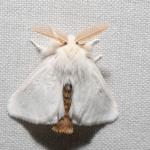
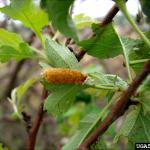
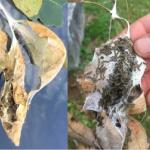 Browntail Moth: (Euproctis chrysorrhoea) is an insect that was accidentally introduced to Massachusetts from Europe in 1897. By the early 1900s, it spread into all of New England and parts of Canada. The caterpillars of this species feed on oak, shadbush, cherry, beach plum, apple, rugosa rose, and other trees and shrubs. While the feeding damage from the caterpillars on landscape specimens may be problematic, the primary cause for concern with regard to browntail moth is medical: the caterpillars of this species possess poisonous hairs that cause a rash similar to poison ivy, and, in some sensitive individuals, may cause trouble breathing or sometimes a more severe allergic reaction.
Browntail Moth: (Euproctis chrysorrhoea) is an insect that was accidentally introduced to Massachusetts from Europe in 1897. By the early 1900s, it spread into all of New England and parts of Canada. The caterpillars of this species feed on oak, shadbush, cherry, beach plum, apple, rugosa rose, and other trees and shrubs. While the feeding damage from the caterpillars on landscape specimens may be problematic, the primary cause for concern with regard to browntail moth is medical: the caterpillars of this species possess poisonous hairs that cause a rash similar to poison ivy, and, in some sensitive individuals, may cause trouble breathing or sometimes a more severe allergic reaction.
UMass Extension was recently made aware of reports of adult browntail moths coming to lights in Essex and Plymouth counties, as well as the Boston area (Chestnut Hill). While the presence of adult browntail moth in locations outside of Cape Cod represents a change in the recent historical distribution of this insect in Massachusetts, we do not believe browntail moth populations are elevated or widespread in MA at this time.
However, due to the medical concerns associated with this insect, we are recommending that green industry professionals working in Massachusetts, particularly in coastal areas of Barnstable, Essex, Norfolk, Plymouth, and Suffolk Counties, should review the information provided here and be able to accurately identify this insect in all life stages. Key in this information is the note that they should avoid touching the caterpillars, pupae/cocoons, or the nests/webbing produced by this pest without protective eyewear, gloves, long sleeves, pants, and other protective clothing. (The adult moths themselves do not seem to produce highly irritating hairs, yet the hairs from the caterpillar and pupal stages may remain on the adults after they emerge.)
For more information, visit: https://ag.umass.edu/landscape/news/time-to-reacquaint-yourself-with-browntail-moth .
To report suspected browntail moth adults (at present, it is the adult stage of this insect that is active at this time of year) in Massachusetts, visit: https://massnrc.org/pests/pestreports.htm .
- Mosquitoes: The Massachusetts Department of Public Health announced on July 1, 2021 that West Nile virus (WNV) was detected in mosquitoes in Massachusetts for the first time this year in a sample collected on June 29 in the town of Medford, MA (Middlesex County). To date, no human or animal cases of WNV or Eastern Equine Encephalitis (EEE) have been detected so far in 2021. For more information, visit: https://www.mass.gov/news/state-public-health-officials-confirm-seasons-first-west-nile-virus-positive-mosquito-sample AND https://www.mass.gov/info-details/massachusetts-arbovirus-update .
According to the Massachusetts Bureau of Infectious Disease and Laboratory Science and the Department of Public Health, there are at least 51 different species of mosquito found in Massachusetts. Mosquitoes belong to the Order Diptera (true flies) and the Family Culicidae (mosquitoes). As such, they undergo complete metamorphosis, and possess four major life stages: egg, larva, pupa, and adult. Adult mosquitoes are the only stage that flies and many female mosquitoes only live for 2 weeks (although the life cycle and timing will depend upon the species). Only female mosquitoes bite to take a blood meal, and this is so they can make eggs. Mosquitoes need water to lay their eggs in, so they are often found in wet or damp locations and around plants. Different species prefer different habitats. It is possible to be bitten by a mosquito at any time of the day, and again timing depends upon the species. Many are particularly active from just before dusk, through the night, and until dawn. Mosquito bites are not only itchy and annoying, but they can be associated with greater health risks. Certain mosquitoes vector pathogens that cause diseases such as West Nile virus (WNV) and eastern equine encephalitis (EEE).
For more information about mosquitoes in Massachusetts, visit: https://www.mass.gov/service-details/mosquitoes-in-massachusetts .
There are ways to protect yourself against mosquitoes, including wearing long-sleeved shirts and long pants, keeping mosquitoes outside by using tight-fitting window and door screens, and using insect repellents as directed. Products containing the active ingredients DEET, permethrin, IR3535, picaridin, and oil of lemon eucalyptus provide protection against mosquitoes.
For more information about mosquito repellents, visit: https://www.mass.gov/service-details/mosquito-repellents and https://www.cdc.gov/mosquitoes/mosquito-bites/prevent-mosquito-bites.html .
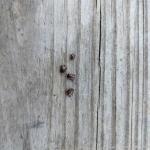
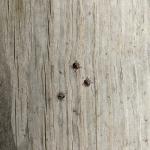 American Dog Tick: Anecdotally, Dermacentor variabilis has been prevalent in certain locations in Massachusetts in 2021. The images shown here are adult stage dog ticks removed from a dog following a roadside walk in Hampshire County on both 5/6/21 (4 ticks removed) and 5/7/21 (3 ticks removed). Looking for more updates? Check out UMass Extension’s Tick Check with Blake Dinius, Plymouth County Extension Service and Larry Dapsis, Cape Cod Cooperative Extension: https://www.youtube.com/watch?v=gryCv8qB1qw .
American Dog Tick: Anecdotally, Dermacentor variabilis has been prevalent in certain locations in Massachusetts in 2021. The images shown here are adult stage dog ticks removed from a dog following a roadside walk in Hampshire County on both 5/6/21 (4 ticks removed) and 5/7/21 (3 ticks removed). Looking for more updates? Check out UMass Extension’s Tick Check with Blake Dinius, Plymouth County Extension Service and Larry Dapsis, Cape Cod Cooperative Extension: https://www.youtube.com/watch?v=gryCv8qB1qw .
The American dog tick is found throughout most of North America. It may be encountered in forest edges, fields, along walkways and roadways, sidewalks, and trails. Adult stage ticks may be found on raccoons, skunks, cats, dogs, and other medium-sized hosts. Larvae and nymphs can be found on mice, voles, rats, and chipmunks. Adult males and females are active between April and early-August. Both adult males and females will feed, including on people. Nymphs and larvae of this species rarely attach to people or their pets. This species of tick can transmit lesser-known diseases such as Rocky Mountain Spotted Fever (not frequently infecting humans, according to CDC reports) and Tularemia (rarely infecting humans, according to CDC reports). For more information about the American dog tick, visit: https://web.uri.edu/tickencounter/species/dog-tick/ .
- Deer Tick/Blacklegged Tick: Check out the archived TickTalk with TickReport webinars available here: https://ag.umass.edu/landscape/education-events/webinars .
*Ixodes scapularis - We are now in the time of year when deer tick larvae and nymphs are frequently encountered. Larvae may be encountered in April, but in some locations may peak in their activity in August, while still being encountered through November. Nymphs are encountered from April through July, peaking in June. Nymphs are again present in October and November. For images of all deer tick life stages, along with an outline of the diseases they carry, and their timing of activity, visit: http://www.tickencounter.org/tick_identification/deer_tick .
Anyone working in the yard and garden should be aware that there is the potential to encounter deer ticks. The deer tick or blacklegged tick can transmit Lyme disease, human babesiosis, human anaplasmosis, and other diseases. Preventative activities, such as daily tick checks, wearing appropriate clothing, and permethrin treatments for clothing (according to label instructions) can aid in reducing the risk that a tick will become attached to your body. If a tick cannot attach and feed, it will not transmit disease. For more information about personal protective measures, visit: http://www.tickencounter.org/prevention/protect_yourself .
The Center for Agriculture, Food, and the Environment provides a list of potential tick identification and testing resources here: https://ag.umass.edu/resources/tick-testing-resources .
*Note that deer ticks (Ixodes scapularis) are not the only disease-causing tick species found in Massachusetts. The American dog tick (Dermacentor variabilis) and the lone star tick (Amblyomma americanum) are also found throughout MA. Each can carry their own complement of diseases, including others not mentioned above. Anyone working or playing in tick habitats (wood-line areas, forested areas, and landscaped areas with ground cover) should check themselves regularly for ticks while practicing preventative measures.
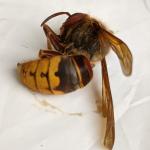
 Wasps/Hornets: Many wasps are predators of other arthropods, including pest insects such as certain caterpillars that feed on trees and shrubs. Adult wasps hunt prey and bring it back to their nest where young are being reared, as food for the immature wasps. A common such example are the paper wasps (Polistes spp.) who rear their young on chewed up insects. They may be seen searching plants for caterpillars and other soft-bodied larvae to feed their young. Paper wasps can sting, and will defend their nests, which are open-celled paper nests that are not covered with a papery “envelope”. These open-celled nests may be seen hanging from eaves or other outdoor building structures. Aerial yellow jackets and hornets create large aerial nests that are covered with a papery shell or “envelope”. Common yellow jacket species include those in the genus Vespula. Dolichovespula maculata is commonly known as the baldfaced hornet, although it is not a true hornet. The European hornet (Vespa crabro) is three times the size of a yellow jacket and may be confused for the Asian giant hornet (Vespa mandarinia). The European hornet is known to Massachusetts, but the Asian giant hornet is not. If you are concerned that you have found or photographed an Asian giant hornet, please report it here: https://massnrc.org/pests/report.aspx . Paper wasps and aerial yellowjackets overwinter as fertilized females (queens) and a single female produces a new nest annually in the late spring. Nests are abandoned at the end of the season. Queens start new nests, lay eggs, and rear new wasps to assist in colony/nest development.Some people are allergic to stinging insects, so care should be taken around wasp/hornet nests. Unlike the European honeybee (Apis mellifera), wasps and hornets do not have barbed stingers, and therefore can sting repeatedly when defending their nests. It is best to avoid their nests, and if that cannot be done and assistance is needed to remove them, consult a professional.
Wasps/Hornets: Many wasps are predators of other arthropods, including pest insects such as certain caterpillars that feed on trees and shrubs. Adult wasps hunt prey and bring it back to their nest where young are being reared, as food for the immature wasps. A common such example are the paper wasps (Polistes spp.) who rear their young on chewed up insects. They may be seen searching plants for caterpillars and other soft-bodied larvae to feed their young. Paper wasps can sting, and will defend their nests, which are open-celled paper nests that are not covered with a papery “envelope”. These open-celled nests may be seen hanging from eaves or other outdoor building structures. Aerial yellow jackets and hornets create large aerial nests that are covered with a papery shell or “envelope”. Common yellow jacket species include those in the genus Vespula. Dolichovespula maculata is commonly known as the baldfaced hornet, although it is not a true hornet. The European hornet (Vespa crabro) is three times the size of a yellow jacket and may be confused for the Asian giant hornet (Vespa mandarinia). The European hornet is known to Massachusetts, but the Asian giant hornet is not. If you are concerned that you have found or photographed an Asian giant hornet, please report it here: https://massnrc.org/pests/report.aspx . Paper wasps and aerial yellowjackets overwinter as fertilized females (queens) and a single female produces a new nest annually in the late spring. Nests are abandoned at the end of the season. Queens start new nests, lay eggs, and rear new wasps to assist in colony/nest development.Some people are allergic to stinging insects, so care should be taken around wasp/hornet nests. Unlike the European honeybee (Apis mellifera), wasps and hornets do not have barbed stingers, and therefore can sting repeatedly when defending their nests. It is best to avoid their nests, and if that cannot be done and assistance is needed to remove them, consult a professional.
Woody ornamental insect and non-insect arthropod pests to consider, a selected few:
Invasive Insects & Other Organisms Update:
![Box tree moth adult. (Matteo Maspero and Andrea Tantardini, Centro MiRT Fondazione Minoprio [IT]) Box tree moth adult. (Matteo Maspero and Andrea Tantardini, Centro MiRT Fondazione Minoprio [IT])](/sites/ag.umass.edu/files/styles/150x150/public/pest-alerts/images/content/box_tree_moth_courtesy_of_matteo_maspero_and_andrea_tantardini_centro_mirt_fondazione_minoprio_it.jpg?itok=pIFkiiQi)
![Box tree moth caterpillars. (Matteo Maspero and Andrea Tantardini, Centro MiRT Fondazione Minoprio [IT]) Box tree moth caterpillars. (Matteo Maspero and Andrea Tantardini, Centro MiRT Fondazione Minoprio [IT])](/sites/ag.umass.edu/files/styles/150x150/public/pest-alerts/images/content/box_tree_moth_caterpillar_courtesy_of_matteo_maspero_and_andrea_tantardini_centro_mirt_fondazione_minoprio_it.jpg?itok=BDTKHKwy) Box Tree Moth: Cydalima perspectalis is native to East Asia. It has become a serious invasive pest in Europe, where it continues to spread. The caterpillars feed mostly on boxwood, and heavy infestations can defoliate host plants. Once the leaves are gone, larvae consume the bark, leading to girdling and plant death. The box tree moth is not currently known to be established in Massachusetts, however the U.S. Department of Agriculture’s Animal and Plant Health Inspection Service (APHIS) is urging professionals and citizens to report any suspicious insects.
Box Tree Moth: Cydalima perspectalis is native to East Asia. It has become a serious invasive pest in Europe, where it continues to spread. The caterpillars feed mostly on boxwood, and heavy infestations can defoliate host plants. Once the leaves are gone, larvae consume the bark, leading to girdling and plant death. The box tree moth is not currently known to be established in Massachusetts, however the U.S. Department of Agriculture’s Animal and Plant Health Inspection Service (APHIS) is urging professionals and citizens to report any suspicious insects.
To report suspected box tree moth life stages or damage to boxwood in Massachusetts, please visit: https://massnrc.org/pests/pestreports.htm .
Females lay eggs singly or in clusters of 5 to more than 20 eggs in a gelatinous mass on the underside of boxwood leaves. Most females deposit more than 42 egg masses in their lifetime. They typically hatch within 4 to 6 days. Pupae typically first appear in April or May and are present continuously through the summer and into the fall, depending on the local climate and timing of generations. Adults first emerge from the overwintering generation between April and July, depending on climate and temperature. Subsequent generations are active between June and October. Adults typically live for two weeks after emergence. The exact timing of the life cycle of this insect in Massachusetts is not currently known.
The Massachusetts Department of Agricultural Resources (MDAR) recently reported that the U.S. Department of Agriculture’s Animal and Plant Health Inspection Service (APHIS) has confirmed the presence of box tree moth in the continental United States and is taking action alongside state partners and industry to contain and eradicate the invasive pest that was imported on nursery plants shipped from Ontario, Canada.
Between August 2020 and April 2021, a nursery in St. Catharines, Ontario shipped boxwood (Buxus species) that may have been infested with box tree moth to locations in six states—25 retail facilities in Connecticut, Massachusetts, Michigan, New York, Ohio, and South Carolina—and a distribution center in Tennessee. At this time, the pest has been identified in three facilities in Michigan, one in Connecticut, and one in South Carolina, and APHIS is working with state plant regulatory officials to determine whether other facilities may be impacted. For more information, visit: https://www.aphis.usda.gov/aphis/newsroom/stakeholder-info/sa_by_date/sa-2021/sa-05/box-tree-moth .
 Spotted Lanternfly: (Lycorma delicatula, SLF) is not known to be established in Massachusetts landscapes at this time. However, due to the great ability of this insect to hitchhike using human-aided movement, it is important that we remain vigilant in Massachusetts and report any suspicious findings. Spotted lanternfly reports can be sent here: https://massnrc.org/pests/slfreport.aspx .
Spotted Lanternfly: (Lycorma delicatula, SLF) is not known to be established in Massachusetts landscapes at this time. However, due to the great ability of this insect to hitchhike using human-aided movement, it is important that we remain vigilant in Massachusetts and report any suspicious findings. Spotted lanternfly reports can be sent here: https://massnrc.org/pests/slfreport.aspx .
The Massachusetts Department of Agricultural Resources has recently released spotted lanternfly Best Management Practices for Nurseries and Landscapers: https://massnrc.org/pests/linkeddocuments/MANurseryBMPs.pdf .
And Best Management Practices for Moving Companies and the Moving Industry: https://massnrc.org/pests/linkeddocuments/SLFChecklistMovingIndustryMA.pdf .
Now is a great time to provide copies of these BMP’s to employees, customers, family, and friends! The more eyes we have out there looking for spotted lanternfly, the better. Use the above BMP’s as a guide to help you inspect certain items coming from CT, DE, MD, NC, NJ, NY, OH, PA, WV, and VA.
UMass Extension is teaming up with UMass Amherst’s Department of Environmental Conservation, the USDA APHIS, and the Massachusetts Department of Agricultural Resources to monitor for the spotted lanternfly in Massachusetts. A team including members of UMass Extension’s Landscape, Nursery, and Urban Forestry Program, Extension’s Fruit Program, Stockbridge School of Agriculture, and the Department of Environmental Conservation at UMass, Amherst are undertaking a nine-month integrated research and extension project to develop effective tools to detect the spotted lanternfly.
The researchers associated with this project (Dr. Joseph Elkinton, Dr. Jeremy Andersen and Dr. Jaime Pinero) will be working with Dr. Miriam Cooperband of the USDA APHIS lab on Cape Cod to identify and evaluate airborne attractants that can improve the ability to detect SLF in traps. Dr. Cooperband has identified several attractant lures released from host plants of SLF. She is currently working on pheromones produced by SLF that may be much more attractive. The UMass team will help her conduct field tests of these new lures, while also assisting the Massachusetts Department of Agricultural Resources (MDAR) in monitoring for SLF in Massachusetts. UMass Extension Entomologist, Tawny Simisky, will periodically report on progress made during the course of this project. For more information, please visit: https://ag.umass.edu/cafe/news/looking-for-spotted-lanternfly-recent-invasive-arrival .
This insect is a member of the Order Hemiptera (true bugs, cicadas, hoppers, aphids, and others) and the Family Fulgoridae, also known as planthoppers. The spotted lanternfly is a non-native species first detected in the United States in Berks County, Pennsylvania and confirmed on September 22, 2014.
For a map of known, established populations of SLF as well as detections outside of these areas where individual finds of spotted lanternfly have occurred (but no infestations are present), visit: https://nysipm.cornell.edu/environment/invasive-species-exotic-pests/spotted-lanternfly/ .
The spotted lanternfly is considered native to China, India, and Vietnam. It has been introduced as a non-native insect to South Korea and Japan, prior to its detection in the United States. In South Korea, it is considered invasive and a pest of grapes and peaches. The spotted lanternfly has been reported feeding on over 103 species of plants, according to new research (Barringer and Ciafré, 2020) and when including not only plants on which the insect feeds, but those that it will lay egg masses on, this number rises to 172. This includes, but is not limited to, the following: tree of heaven (Ailanthus altissima) (preferred host), apple (Malus spp.), plum, cherry, peach, apricot (Prunus spp.), grape (Vitis spp.), pine (Pinus spp.), pignut hickory (Carya glabra), sassafras (Sassafras albidum), serviceberry (Amelanchier spp.), slippery elm (Ulmus rubra), tulip poplar (Liriodendron tulipifera), white ash (Fraxinus americana), willow (Salix spp.), American beech (Fagus grandifolia), American linden (Tilia americana), American sycamore (Platanus occidentalis), big-toothed aspen (Populus grandidentata), black birch (Betula lenta), black cherry (Prunus serotina), black gum (Nyssa sylvatica), black walnut (Juglans nigra), dogwood (Cornus spp.), Japanese snowbell (Styrax japonicus), maple (Acer spp.), oak (Quercus spp.), and paper birch (Betula papyrifera).
The adults and immatures of this species damage host plants by feeding on sap from stems, leaves, and the trunks of trees. In the springtime in Pennsylvania (late April - mid-May) nymphs (immatures) are found on smaller plants and vines and new growth of trees and shrubs. Third and fourth instar nymphs migrate to the tree of heaven and are observed feeding on trunks and branches. Trees may be found with sap weeping from the wounds caused by the insect’s feeding. The sugary secretions (excrement) created by this insect may coat the host plant, later leading to the growth of sooty mold. Insects such as wasps, hornets, bees, and ants may also be attracted to the sugary waste created by the lanternflies, or sap weeping from open wounds in the host plant. Host plants have been described as giving off a fermented odor when this insect is present.
Adults are present by the middle of July in Pennsylvania and begin laying eggs by late September and continue laying eggs through late November and even early December in that state. Adults may be found on the trunks of trees such as the tree of heaven or other host plants growing in close proximity to them. Egg masses of this insect are gray in color and look similar in some ways to gypsy moth egg masses.
Host plants, bricks, stone, lawn furniture, recreational vehicles, and other smooth surfaces can be inspected for egg masses. Egg masses laid on outdoor residential items such as those listed above may pose the greatest threat for spreading this insect via human aided movement.
For more information about the spotted lanternfly, visit this fact sheet: https://ag.umass.edu/landscape/fact-sheets/spotted-lanternfly .
- Emerald Ash Borer: (Agrilus planipennis, EAB) in 2021 alone, the Massachusetts Department of Conservation and Recreation has confirmed at least 28 new community detections of emerald ash borer in Massachusetts. To date, 11 out of the 14 counties in Massachusetts have confirmed emerald ash borer. (The remaining counties where EAB has yet to be detected are Barnstable, Dukes, and Nantucket counties.)A map of these locations and others previously known across the state may be found here: https://ag.umass.edu/fact-sheets/emerald-ash-borer .
This wood-boring beetle readily attacks ash (Fraxinus spp.) including white, green, and black ash and has also been found developing in white fringe tree (Chionanthus virginicus) and has been reported in cultivated olive (Olea europaea). Signs of an EAB infested tree may include D-shaped exit holes in the bark (from adult emergence), “blonding” or lighter coloration of the ash bark from woodpecker feeding (chipping away of the bark as they search for larvae beneath), and serpentine galleries visible through splits in the bark, from larval feeding beneath. It is interesting to note that woodpeckers are capable of eating 30-95% of the emerald ash borer larvae found in a single tree (Murphy et al. 2018). Unfortunately, despite high predation rates, EAB populations continue to grow.
For further information about this insect, please visit: https://ag.umass.edu/fact-sheets/emerald-ash-borer . If you believe you have located EAB-infested ash trees, particularly in an area of Massachusetts not identified on the map provided, please report here: https://massnrc.org/pests/eabreport.htm .
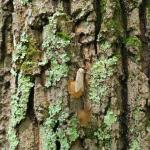
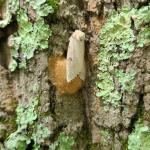
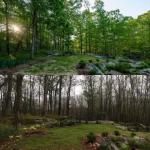 Lymantria dispar (formerly Gypsy Moth; LD) thanks to the LD caterpillar killing fungus, Entomophaga maimaiga, the recent widespread outbreak of the insect (formerly known as gypsy moth) in Massachusetts has come to an end! Most locations in Massachusetts have not seen damaging or even noticeable populations of this insect in 2021. However, there have been reports of LD caterpillars feeding on susceptible hosts in some locations in western Massachusetts, particularly in parts of Berkshire County (ex. Alford, Great Barrington, Richmond, Sheffield, South Egremont, and Williamstown). (Ex. On 6/9/21, a report from Great Barrington, MA noted that caterpillars were defoliating trees in a forested area, and that caterpillar frass (excrement) was seen raining down from the canopy.) While this may be the case in certain locations, we do not expect widespread defoliation (to the extent that we saw in 2017) from this insect in 2021 in MA. Another note for 6/9/2021: there have been reports of increased LD caterpillar activity in certain locations in New York. Massachusetts residents vacationing or with second homes in that state are reporting defoliation on oaks and pines in NY. For more information, visit: https://www.dec.ny.gov/animals/83118.html . An update from 6/22/2021: defoliation of the canopy has been observed by professionals working in Litchfield County, CT. On 7/7/2021, professionals working in the Sharon and West Cornwall areas of CT, parts of Berkshire County, MA, and parts of Columbia County, NY are reporting defoliation caused by LD caterpillars. On 7/7/2021, hundreds of LD moth males were reported flying in Sheffield, MA (Berkshire County) and mating with adult females who were also laying egg masses on trees. Reports indicate that some caterpillars are just getting ready to pupate, others have pupated, and adults have emerged. LD caterpillar feeding is at an end for the 2021 growing season in these locations.
Lymantria dispar (formerly Gypsy Moth; LD) thanks to the LD caterpillar killing fungus, Entomophaga maimaiga, the recent widespread outbreak of the insect (formerly known as gypsy moth) in Massachusetts has come to an end! Most locations in Massachusetts have not seen damaging or even noticeable populations of this insect in 2021. However, there have been reports of LD caterpillars feeding on susceptible hosts in some locations in western Massachusetts, particularly in parts of Berkshire County (ex. Alford, Great Barrington, Richmond, Sheffield, South Egremont, and Williamstown). (Ex. On 6/9/21, a report from Great Barrington, MA noted that caterpillars were defoliating trees in a forested area, and that caterpillar frass (excrement) was seen raining down from the canopy.) While this may be the case in certain locations, we do not expect widespread defoliation (to the extent that we saw in 2017) from this insect in 2021 in MA. Another note for 6/9/2021: there have been reports of increased LD caterpillar activity in certain locations in New York. Massachusetts residents vacationing or with second homes in that state are reporting defoliation on oaks and pines in NY. For more information, visit: https://www.dec.ny.gov/animals/83118.html . An update from 6/22/2021: defoliation of the canopy has been observed by professionals working in Litchfield County, CT. On 7/7/2021, professionals working in the Sharon and West Cornwall areas of CT, parts of Berkshire County, MA, and parts of Columbia County, NY are reporting defoliation caused by LD caterpillars. On 7/7/2021, hundreds of LD moth males were reported flying in Sheffield, MA (Berkshire County) and mating with adult females who were also laying egg masses on trees. Reports indicate that some caterpillars are just getting ready to pupate, others have pupated, and adults have emerged. LD caterpillar feeding is at an end for the 2021 growing season in these locations.
LD moth has been in Massachusetts since the 1860's. This invasive insect from Europe often goes unnoticed, thanks to population regulation provided by the entomopathogenic fungus, E. maimaiga, as well as a NPV virus specific to LD moth caterpillars. (And to a lesser extent many other organisms, including other insects, small mammals, and birds who feed on LD moth.) However, if environmental conditions do not favor the life cycle of the fungus, outbreaks of LD moth caterpillars are possible. (Such as most recently from 2015-2018, with a peak in the LD moth population in 2017 in Massachusetts.)
Check out Episode 1 of InsectXaminer to reminisce about the 2015-2018 outbreak of this insect and learn more about the fungus and the virus and how to recognize caterpillars that have been killed by these pathogens: https://ag.umass.edu/landscape/education-events/insectxaminer .
- Asian Longhorned Beetle: (Anoplophora glabripennis, ALB) Look for signs of an ALB infestation which include perfectly round exit holes (about the size of a dime), shallow oval or round scars in the bark where a female has chewed an egg site, or sawdust-like frass (excrement) on the ground nearby host trees or caught in between branches. Be advised that other, native insects may create perfectly round exit holes or sawdust-like frass, which can be confused with signs of ALB activity.
The regulated area for Asian longhorned beetle is 110 miles2 encompassing Worcester, Shrewsbury, Boylston, West Boylston, and parts of Holden and Auburn. If you believe you have seen damage caused by this insect, such as exit holes or egg sites, on susceptible host trees like maple, please call the Asian Longhorned Beetle Eradication Program office in Worcester, MA at 508-852-8090 or toll free at 1-866-702-9938.
To report an Asian longhorned beetle find online or compare it to common insect look-alikes, visit: http://massnrc.org/pests/albreport.aspx or https://www.aphis.usda.gov/pests-diseases/alb/report .
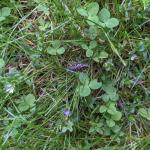
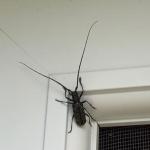 White Spotted Pine Sawyer (WSPS): Monochamus scutellatus adults emerge in late May throughout July, depending on local temperatures. This is a native insect in Massachusetts and is usually not a pest. Larvae develop in weakened or recently dead conifers, particularly eastern white pine (Pinus strobus). However, the white spotted pine sawyer looks very similar to the invasive Asian Longhorned Beetle, Anoplophora glabripennis, ALB. ALB adults do not emerge in Massachusetts until July and August. Beginning in July, look for the key difference between WSPS and ALB adults, which is a white spot in the top center of the wing covers (the scutellum) on the back of the beetle. White spotted pine sawyer will have this white spot, whereas Asian longhorned beetle will not. Both insects can have other white spots on the rest of their wing covers; however, the difference in the color of the scutellum is a key characteristic. See the Asian longhorned beetle entry above for more information about that non-native insect.
White Spotted Pine Sawyer (WSPS): Monochamus scutellatus adults emerge in late May throughout July, depending on local temperatures. This is a native insect in Massachusetts and is usually not a pest. Larvae develop in weakened or recently dead conifers, particularly eastern white pine (Pinus strobus). However, the white spotted pine sawyer looks very similar to the invasive Asian Longhorned Beetle, Anoplophora glabripennis, ALB. ALB adults do not emerge in Massachusetts until July and August. Beginning in July, look for the key difference between WSPS and ALB adults, which is a white spot in the top center of the wing covers (the scutellum) on the back of the beetle. White spotted pine sawyer will have this white spot, whereas Asian longhorned beetle will not. Both insects can have other white spots on the rest of their wing covers; however, the difference in the color of the scutellum is a key characteristic. See the Asian longhorned beetle entry above for more information about that non-native insect.
- Jumping Worms: In recent years, public concern about Amynthas spp. earthworms, collectively referred to as “jumping or crazy or snake” worms, has dramatically increased. University researchers and Extension groups in many locations in the US are finding that these species cause not only forest ecosystem disturbances, but may also negatively impact soil structure and reduce plant growth in gardens and managed landscapes. They do this by voraciously devouring the organic layer of the soil while feeding very close to the soil surface, unlike other species of earthworms. In woodland areas, they can quickly eat all of the leaf litter on the forest floor. Jumping worms also leave a distinct grainy soil full of worm castings. The soil becomes granular and may look like dried coffee grounds.
Unfortunately, there are currently no research-based management options available for these earthworms. So prevention is essential – preventing their introduction and spread into new areas is the best defense against them. Adult jumping worms can be 1.5 – 8 inches or more in length. Their clitellum (collar-like ring) is roughly located 1/3 down the length of the worm (from the head) and is smooth and cloudy-white and constricted. These worms may also wiggle or jump when disturbed, and can move across the ground in an S-shape like a snake. While the exact timing of their life cycle in MA might not be completely understood, their life cycle may be expected to go (roughly) something like this: they hatch in the late spring in 1-4 inches of soil, mature into adults during the summer and adults lay eggs sometime in August, and it is thought that their cocoons overwinter. (Adults perish with frost.) It is also worth noting here that jumping worms do not directly harm humans or pets.
For more information, listen to Dr. Olga Kostromytska’s presentation here: https://ag.umass.edu/landscape/education-events/invasive-insect-webinars .
Suggested reading includes Dr. Kostromytska’s recent “Hot Topics” article in Hort Notes (including an identification guide), here: https://ag.umass.edu/landscape/newsletters/hort-notes/hort-notes-2021-vol-323 .
Additional resources can also be found here:
University of Minnesota Extension: https://extension.umn.edu/identify-invasive-species/jumping-worms .
Cornell Cooperative Extension: http://ulster.cce.cornell.edu/environment/invasive-pests/jumping-worm .
UNH Extension: https://extension.unh.edu/blog/invasive-spotlight-jumping-worms .
Tree & Shrub Insects & Mites:
- Arborvitae Leafminer: In New England and eastern Canada, four species of leafminers are known to infest arborvitae. These include Argyresthia thuiella, A. freyella, A. aureoargentella, and Coleotechnites thujaella. The arborvitae leafminer, A. thuiella, is the most abundant of these and has the greatest known range when compared to the others. (It is also found in the Mid-Atlantic States and as far west as Missouri). Moths of this species appear from mid-June to mid-July and lay their eggs. The damage caused by all of these species is nearly identical. Trees, however, have been reported to lose up to 80% of their foliage due to arborvitae leafminer and still survive. At least 27 species of parasites have been reported as natural enemies of arborvitae leafminers, the most significant of which may be a parasitic wasp (Pentacnemus bucculatricis). Arborvitae leafminer damage causes the tips of shoots and foliage to turn yellow and brown. If infestations are light, prune out infested tips.
- Asiatic Garden Beetle: Maladera castanea adults are active and are typically most abundant in July and August. These rusty-red colored beetles are bullet-shaped and active at night. They are often attracted to porch lights. They feed on a number of ornamental plants, defoliating leaves by giving the edges a ragged appearance and also feeding on blossoms. Butterfly bush, rose, dahlia, aster, and chrysanthemum can be favored hosts. Certain neem oil products are labelled for use against adult beetles. Observe label instructions to minimize the potential for leaf injury.

 Azalea Sawflies: There are a few species of sawflies that impact azaleas. Johnson and Lyon's Insects that Feed on Trees and Shrubs mentions three of them. Amauronematus azaleae was first reported in New Hampshire in 1895 and is likely found in most of New England. Adults of this species are black with some white markings and wasp-like. Generally green larvae feed mostly on mollis hybrid azaleas. Remember, sawfly caterpillars have at least enough abdominal prolegs to spell “sawfly” (so 6 or more prolegs). Adults are present in May, and females lay their eggs and then larvae hatch and feed through the end of June. There is one generation per year. Nematus lipovskyi has been reared from swamp azalea (Rhododendron viscosum). Adults of that species have been collected in April (in states to the south) and May (in New England) and larval feeding is predominantly in late April and May in Virginia and June in New England. One generation of this species occurs per year, and most mollis hybrid azaleas can be impacted. A third species, Arge clavicornis, is found as an adult in July and lays its eggs in leaf edges in rows. Larvae are present in August and September. Remember, Bacillus thuringiensis Kurstaki does not manage sawflies.
Azalea Sawflies: There are a few species of sawflies that impact azaleas. Johnson and Lyon's Insects that Feed on Trees and Shrubs mentions three of them. Amauronematus azaleae was first reported in New Hampshire in 1895 and is likely found in most of New England. Adults of this species are black with some white markings and wasp-like. Generally green larvae feed mostly on mollis hybrid azaleas. Remember, sawfly caterpillars have at least enough abdominal prolegs to spell “sawfly” (so 6 or more prolegs). Adults are present in May, and females lay their eggs and then larvae hatch and feed through the end of June. There is one generation per year. Nematus lipovskyi has been reared from swamp azalea (Rhododendron viscosum). Adults of that species have been collected in April (in states to the south) and May (in New England) and larval feeding is predominantly in late April and May in Virginia and June in New England. One generation of this species occurs per year, and most mollis hybrid azaleas can be impacted. A third species, Arge clavicornis, is found as an adult in July and lays its eggs in leaf edges in rows. Larvae are present in August and September. Remember, Bacillus thuringiensis Kurstaki does not manage sawflies.
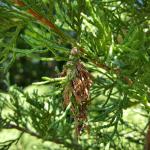 Bagworm: Thyridopteryx ephemeraeformis is a native species of moth whose larvae construct bag-like coverings over themselves with host plant leaves and twigs. In certain areas across MA in 2020, increased populations of bagworms were observed and reported, particularly in urban forest settings and managed landscapes. More information can be found here: https://ag.umass.edu/landscape/fact-sheets/bagworm .
Bagworm: Thyridopteryx ephemeraeformis is a native species of moth whose larvae construct bag-like coverings over themselves with host plant leaves and twigs. In certain areas across MA in 2020, increased populations of bagworms were observed and reported, particularly in urban forest settings and managed landscapes. More information can be found here: https://ag.umass.edu/landscape/fact-sheets/bagworm .- Cottony Taxus Scale: Pulvinaria floccifera, also referred to as the cottony camellia scale, utilizes such hosts as taxus, camellia, holly, hydrangea, Japanese maple, euonymus, magnolia, and jasmine, among others. Females have laid the long, narrow, white and fluffy egg sac that makes them much more noticeable. Eggs will hatch over an extended period of 6 weeks and crawlers may be treated between 802-1388 GDD’s. This insect can cause the host to appear off-color. They also produce honeydew which promotes sooty mold growth. Dieback is not common with this insect. Target the underside of the foliage. Horticultural oil, neem oil, and insecticidal soaps may be used to manage these soft scales. Reduced risk options help preserve natural enemies.
- Dogwood Borer: Synanthedon scitula is a species of clearwing moth whose larvae bore not only into dogwood (Cornus), but hosts also include flowering cherry, chestnut, apple, mountain ash, hickory, pecan, willow, birch, bayberry, oak, hazel, myrtle, and others. Kousa dogwood appear to be resistant to this species. Signs include the sloughing of loose bark, brown frass, particularly near bark cracks and wounds, dead branches, and adventitious growth. The timing of adult emergence can be expected when dogwood flower petals are dropping and weigela begins to bloom. Adult moth flights continue from then until September. Emergence in some hosts (ex. apple) appears to be delayed, but this differs depending upon the location in this insect’s range. Eggs are laid singly, or in small groups, on smooth and rough bark. Female moths preferentially lay eggs near wounded bark. After hatch, larvae wander until they find a suitable entrance point into the bark. This includes wounds, scars, or branch crotches. This insect may also be found in twig galls caused by other insects or fungi. Larvae feed on phloem and cambium. Fully grown larvae are white with a light brown head and approx. ½ inch long. Pheromone traps and lures are useful for determining the timing of adult moth emergence and subsequent management.

 Dogwood Sawfly: Macremphytus tarsatus larvae are commonly seen feeding on dogwoods, especially gray dogwood (Cornus racemosa). One generation occurs per year. The larvae of the dogwood sawfly overwinter in decaying wood and occasionally (rarely) compromised structural timber. An overwintering “cell” is created in this soft wood. Pupation occurs in the springtime and adults can take a lengthy time to emerge, roughly from late May through July. 100+ eggs are laid in groups on the underside of leaves. Eggs hatch and the larvae feed gregariously, initially skeletonizing the leaves. As the caterpillars grow in size, they are capable of eating the entire leaf, leaving only midveins behind. Larval appearance varies greatly throughout instars. Early instars are translucent and yellow, but as the caterpillars grow, they develop black spots (over the yellow) and become covered in a white powder-like material. Larvae and their shed skins may resemble bird droppings. Full-grown larvae begin to wander in search of a suitable overwintering location. Rotting wood lying on the ground is preferred for this. Sawfly caterpillars can be collected from plants and dropped into a can of soapy water.
Dogwood Sawfly: Macremphytus tarsatus larvae are commonly seen feeding on dogwoods, especially gray dogwood (Cornus racemosa). One generation occurs per year. The larvae of the dogwood sawfly overwinter in decaying wood and occasionally (rarely) compromised structural timber. An overwintering “cell” is created in this soft wood. Pupation occurs in the springtime and adults can take a lengthy time to emerge, roughly from late May through July. 100+ eggs are laid in groups on the underside of leaves. Eggs hatch and the larvae feed gregariously, initially skeletonizing the leaves. As the caterpillars grow in size, they are capable of eating the entire leaf, leaving only midveins behind. Larval appearance varies greatly throughout instars. Early instars are translucent and yellow, but as the caterpillars grow, they develop black spots (over the yellow) and become covered in a white powder-like material. Larvae and their shed skins may resemble bird droppings. Full-grown larvae begin to wander in search of a suitable overwintering location. Rotting wood lying on the ground is preferred for this. Sawfly caterpillars can be collected from plants and dropped into a can of soapy water.

 Elm Casebearer: Coleophora ulmifoliella is a native North American moth that is found throughout New England and west to Michigan. Host plants include American, red, and slippery elm. Moths are tiny, with wing spans of approximately 13 mm. and buff in color with gray markings. According to Johnson and Lyon’s “Insects that Feed on Trees and Shrubs”, adult moths fly and mate and females lay eggs in July, at which point the eggs hatch and the larvae of the insect enter the host plant leaves to feed as miners between the epidermal layers of the leaf. As the larva grows in size, it emerges from the leaf it was mining and creates a case, which grows in size with it. This case serves as a protective covering, which the larva adorns itself with through the rest of the larval stage. Mines look like rectangular spots in the leaves that are brown in color. As the weather cools in the fall, the casebearer larva migrates to the twigs of its host plant, where it ties the case in one location to spend the winter as an immature larva. The following spring, the casebearer migrates to new leaves and resumes feeding as a miner, however it does this while dragging its case behind it and never allowing its body to completely leave the case. Elm casebearer cases are approximately 6 mm. in length. Once fully mature, the larvae pupate (within their individual cases) and adult moths emerge in July. A single generation occurs per year.
Elm Casebearer: Coleophora ulmifoliella is a native North American moth that is found throughout New England and west to Michigan. Host plants include American, red, and slippery elm. Moths are tiny, with wing spans of approximately 13 mm. and buff in color with gray markings. According to Johnson and Lyon’s “Insects that Feed on Trees and Shrubs”, adult moths fly and mate and females lay eggs in July, at which point the eggs hatch and the larvae of the insect enter the host plant leaves to feed as miners between the epidermal layers of the leaf. As the larva grows in size, it emerges from the leaf it was mining and creates a case, which grows in size with it. This case serves as a protective covering, which the larva adorns itself with through the rest of the larval stage. Mines look like rectangular spots in the leaves that are brown in color. As the weather cools in the fall, the casebearer larva migrates to the twigs of its host plant, where it ties the case in one location to spend the winter as an immature larva. The following spring, the casebearer migrates to new leaves and resumes feeding as a miner, however it does this while dragging its case behind it and never allowing its body to completely leave the case. Elm casebearer cases are approximately 6 mm. in length. Once fully mature, the larvae pupate (within their individual cases) and adult moths emerge in July. A single generation occurs per year.
Damage from a single elm casebearer larva is negligible and does not require management. However, on occasion, elevated populations of this insect do occur and noticeable injury to host plant leaves can transpire. Complete browning and death of leaves can occur, if high populations are present. Chemical management of this native insect is not necessary unless the majority of leaves contain more than a single larva.
- Elongate Hemlock Scale: Fiorinia externa is found on eastern, Carolina, and Japanese hemlock, as well as yew, spruce, and fir. The elongate hemlock scale may overwinter in various life stages, and overlap of many developmental stages at any given time can be observed throughout much of the season. Nitrogen fertilizer applications may make elongate hemlock scale infestations worse.
- Exomala (Anomala) orientalis: is another introduced species (first detected in CT in 1920 from Japan) in the scarab beetle family (Scarabaeidae) that is typically smaller than the Japanese beetle as an adult. Adults are typically 4/10 of an inch, with the stout (broad) body typical of scarabs. Adult coloration can be variable, ranging from a black color to mottled gray with black patches/patterned markings. Exomala orientalis beetles can feed on flowers such as daisy, roses, phlox, and petunia as adults; although typically, the feeding by the adults is not severe. Larvae often coexist with those of the Japanese beetle and can be very difficult to distinguish from them. Larvae can damage the roots of turf grasses as well as the roots of many nursery plants and small fruits, including containerized plants. Common ornamental hosts include hemlock, holly, rhododendron, azalea, juniper, and andromeda. Adults are seen typically in mid-June and can be found through at least early August in MA. By late July, the larvae can cause serious damage to turfgrass and ornamental plants. The roots may be eaten and the crown girdled. This may lead to wilting and yellowing of foliage. Hand-pick adults when appropriate.
 Fall Webworm: Hyphantria cunea is native to North America and Mexico. It is now considered a world-wide pest, as it has spread throughout much of Europe and Asia. (For example, it was introduced accidentally into Hungary from North America in the 1940’s.) Hosts include nearly all shade, fruit, and ornamental trees except conifers. In the USA, at least 88 species of trees are hosts for these insects, while in Europe at least 230 species are impacted. In the past history of this pest, it was once thought that the fall webworm was a two-species complex. It is now thought that H. cunea has two color morphs – one black headed and one red headed. These two color forms differ not only in the coloration of the caterpillars and the adults, but also in their behaviors. Caterpillars may go through at least 11 molts, each stage occurring within a silken web they produce over the host. When alarmed, all caterpillars in the group will move in unison in jerking motions that may be a mechanism for self-defense. Depending upon the location and climate, 1-4 generations of fall webworm can occur per year. Fall webworm adult moths lay eggs on the underside of the leaves of host plants in the spring. These eggs hatch in late June or early July depending on climate. Young larvae feed together in groups on the undersides of leaves, first skeletonizing the leaf and then enveloping other leaves and eventually entire branches within their webs. Webs are typically found on the terminal ends of branches. All caterpillar activity occurs within this tent, which becomes filled with leaf fragments, cast skins, and frass. Fully grown larvae then wander from the webs and pupate in protected areas such as the leaf litter where they will remain for the winter. Adult fall webworm moths emerge the following spring/early summer to start the cycle over again. 50+ species of parasites and 36+ species of predators are known to attack fall webworm in North America. Fall webworms typically do not cause extensive damage to their hosts. Nests may be an aesthetic issue for some. If in reach, small fall webworm webs may be pruned out of trees and shrubs and destroyed. Do not set fire to H. cunea webs when they are still attached to the host plant.
Fall Webworm: Hyphantria cunea is native to North America and Mexico. It is now considered a world-wide pest, as it has spread throughout much of Europe and Asia. (For example, it was introduced accidentally into Hungary from North America in the 1940’s.) Hosts include nearly all shade, fruit, and ornamental trees except conifers. In the USA, at least 88 species of trees are hosts for these insects, while in Europe at least 230 species are impacted. In the past history of this pest, it was once thought that the fall webworm was a two-species complex. It is now thought that H. cunea has two color morphs – one black headed and one red headed. These two color forms differ not only in the coloration of the caterpillars and the adults, but also in their behaviors. Caterpillars may go through at least 11 molts, each stage occurring within a silken web they produce over the host. When alarmed, all caterpillars in the group will move in unison in jerking motions that may be a mechanism for self-defense. Depending upon the location and climate, 1-4 generations of fall webworm can occur per year. Fall webworm adult moths lay eggs on the underside of the leaves of host plants in the spring. These eggs hatch in late June or early July depending on climate. Young larvae feed together in groups on the undersides of leaves, first skeletonizing the leaf and then enveloping other leaves and eventually entire branches within their webs. Webs are typically found on the terminal ends of branches. All caterpillar activity occurs within this tent, which becomes filled with leaf fragments, cast skins, and frass. Fully grown larvae then wander from the webs and pupate in protected areas such as the leaf litter where they will remain for the winter. Adult fall webworm moths emerge the following spring/early summer to start the cycle over again. 50+ species of parasites and 36+ species of predators are known to attack fall webworm in North America. Fall webworms typically do not cause extensive damage to their hosts. Nests may be an aesthetic issue for some. If in reach, small fall webworm webs may be pruned out of trees and shrubs and destroyed. Do not set fire to H. cunea webs when they are still attached to the host plant.-
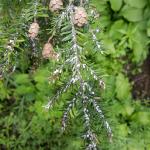 Hemlock Woolly Adelgid: Adelges tsugae is present on eastern and Carolina hemlock. The overwintering hemlock woolly adelgid generation (sistens) is present through mid-spring and produces the spring generation (progrediens) which will be present from early spring through mid-summer. HWA, unlike many other insects, does most of its feeding over the winter. Eggs may be found in woolly masses at the base of hemlock needles beginning in mid-March. Each woolly mass is created by a female who may then lay 50-300 eggs. Eggs hatch and crawlers may be found from mid-March through mid-July. Infested trees may be treated with foliar sprays in late April to early May, using Japanese quince as a phenological indicator. Systemic applications may be made in the spring and fall, or when soil conditions are favorable for translocation to foliage. Nitrogen fertilizer applications may make hemlock woolly adelgid infestations worse.
Hemlock Woolly Adelgid: Adelges tsugae is present on eastern and Carolina hemlock. The overwintering hemlock woolly adelgid generation (sistens) is present through mid-spring and produces the spring generation (progrediens) which will be present from early spring through mid-summer. HWA, unlike many other insects, does most of its feeding over the winter. Eggs may be found in woolly masses at the base of hemlock needles beginning in mid-March. Each woolly mass is created by a female who may then lay 50-300 eggs. Eggs hatch and crawlers may be found from mid-March through mid-July. Infested trees may be treated with foliar sprays in late April to early May, using Japanese quince as a phenological indicator. Systemic applications may be made in the spring and fall, or when soil conditions are favorable for translocation to foliage. Nitrogen fertilizer applications may make hemlock woolly adelgid infestations worse. 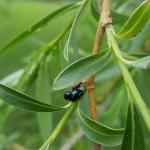
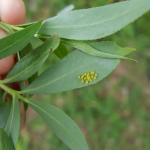 Imported Willow Leaf Beetle: Plagiodera versicolora adult beetles overwinter near susceptible hosts. Adult beetles will chew holes and notches in the leaves of willow once they become available. Females lay yellow eggs in clusters on the undersides of leaves. Larvae are slug-like and bluish-green in color. They will feed in clusters and skeletonize the leaves. Most plants can tolerate the feeding from this insect, and foliage will appear brown. Repeated yearly feeding can be an issue, in which case management of the young larvae may be necessary. Take care with treatment in areas near water.
Imported Willow Leaf Beetle: Plagiodera versicolora adult beetles overwinter near susceptible hosts. Adult beetles will chew holes and notches in the leaves of willow once they become available. Females lay yellow eggs in clusters on the undersides of leaves. Larvae are slug-like and bluish-green in color. They will feed in clusters and skeletonize the leaves. Most plants can tolerate the feeding from this insect, and foliage will appear brown. Repeated yearly feeding can be an issue, in which case management of the young larvae may be necessary. Take care with treatment in areas near water.
Check out Episode 4 of InsectXaminer to see the imported willow leaf beetle in action and learn more about its life cycle: https://ag.umass.edu/landscape/education-events/insectxaminer .
- Lacebugs: Stephanitis spp. lacebugs such as S. pyriodes can cause severe injury to azalea foliage. S. rhododendri can be common on rhododendron and mountain laurel. S. takeyai has been found developing on Japanese andromeda, leucothoe, styrax, and willow. Stephanitis spp. lace bug activity should be monitored through September. Before populations become too large, treat with a summer rate horticultural oil spray as needed. Be sure to target the undersides of the foliage in order to get proper coverage of the insects. Certain azalea and andromeda cultivars may be less preferred by lace bugs.
- Lilac Borer: Podosesia syringae is a clearwing moth pest of lilac, privet, fringetree, and ash. (It is also known as the ash borer, not to be confused with the emerald ash borer.) Adults mimic paper wasps. Larvae are wood-boring, and signs and symptoms include branch dieback, holes, and occasionally, sawdust-like frass accumulated on bark. Larvae bore into stems, trunks, and branches, chewing an irregularly shaped entrance hole. Peak adult moth flights may occur in the northern portion of this insect’s range in June and is usually over by August 1st. Pheromone traps can be used to time adult emergence. Adult females lay flattened, oval, and tan eggs that are deposited singly or in clusters on bark crevices, ridges, and sometimes smooth bark; but usually laid in or near wounds in the bark. On average, 395 eggs are laid by each female. After hatch, larvae chew into the bark and feed laterally and then vertically in phloem tissue. Larvae overwinter in tunnels in the final instar and resume feeding in the spring. Adults emerge through a round exit hole (4-5 mm. in diameter). This insectmay be targeted between 200-299 GDD’s, base 50°F.
 Magnolia Scale: Neolecanium cornuparvum is a soft scale that overwinters as first instar nymphs which are elliptical, and dark slate gray in color and can usually be found on the undersides of 1 and 2-year old twigs. Nymphs may molt by late April or May and again by early June at which time the scales may be purple in color. Eventually nymphs secrete a white powdery layer of wax over their bodies. On magnolia hosts, these large soft scales could either be Neolecanium cornuparvum, the magnolia scale, or Toumeyella liriodendri, the tuliptree scale. The tuliptree scale can be found both on magnolia and tuliptree hosts, whereas the magnolia scale is only known to magnolia. Differentiation between these two species of scale (on magnolia) can be difficult in the field. Soft scale nymphs were found on 6/23/2021 in Hampshire County, MA on Magnolia stellata ‘Royal Star’. A coating of black sooty mold also covered stems and twigs. Natural enemies of soft scales and other pests were also present- the mealybug destroyer (Cryptolaemus montrouzieri) and Hyperaspis spp. ladybeetle larvae.
Magnolia Scale: Neolecanium cornuparvum is a soft scale that overwinters as first instar nymphs which are elliptical, and dark slate gray in color and can usually be found on the undersides of 1 and 2-year old twigs. Nymphs may molt by late April or May and again by early June at which time the scales may be purple in color. Eventually nymphs secrete a white powdery layer of wax over their bodies. On magnolia hosts, these large soft scales could either be Neolecanium cornuparvum, the magnolia scale, or Toumeyella liriodendri, the tuliptree scale. The tuliptree scale can be found both on magnolia and tuliptree hosts, whereas the magnolia scale is only known to magnolia. Differentiation between these two species of scale (on magnolia) can be difficult in the field. Soft scale nymphs were found on 6/23/2021 in Hampshire County, MA on Magnolia stellata ‘Royal Star’. A coating of black sooty mold also covered stems and twigs. Natural enemies of soft scales and other pests were also present- the mealybug destroyer (Cryptolaemus montrouzieri) and Hyperaspis spp. ladybeetle larvae.
 The mealybug destroyer (Cryptolaemus montrouzieri) is a ladybeetle that was brought to the United States from Australia in 1891 by one of the early biological control pioneers in an effort to manage the citrus mealybug in California. The mealybug destroyer is a small dark brown lady beetle with a tan or orange head as an adult. Larvae have woolly appendages of wax, causing them to resemble mealybugs. This insect will feed not only on citrus mealybug, but soft scales and the long-tailed mealybug. A single larva can eat up to 250 mealybugs – they are voracious predators. Remember, the mealybug destroyer resembles its prey (a wolf in sheep’s clothing, if you will), so it is important to be able to identify this predator. C. montrouzieri is not known to be able to survive cold winters.
The mealybug destroyer (Cryptolaemus montrouzieri) is a ladybeetle that was brought to the United States from Australia in 1891 by one of the early biological control pioneers in an effort to manage the citrus mealybug in California. The mealybug destroyer is a small dark brown lady beetle with a tan or orange head as an adult. Larvae have woolly appendages of wax, causing them to resemble mealybugs. This insect will feed not only on citrus mealybug, but soft scales and the long-tailed mealybug. A single larva can eat up to 250 mealybugs – they are voracious predators. Remember, the mealybug destroyer resembles its prey (a wolf in sheep’s clothing, if you will), so it is important to be able to identify this predator. C. montrouzieri is not known to be able to survive cold winters.
 Hyperaspis spp. lady beetles may also be confused for mealybugs when they are in their larval stage. Adults of this genus may be tiny, black, and oval ladybugs with various red or orange markings or spots on the wings and thorax, depending upon the species. They feed on the egg masses of scale insects and appear at the same time scales begin to lay their eggs. Adults lay eggs on bark or leaves nearby scale infestations. Once the ladybeetle eggs hatch, their larvae feed on the eggs of the scales and grow in size. As the Hyperaspis spp. ladybeetle larvae grow in size, they secrete a dense, white, fluffy covering, causing them to resemble mealybugs.
Hyperaspis spp. lady beetles may also be confused for mealybugs when they are in their larval stage. Adults of this genus may be tiny, black, and oval ladybugs with various red or orange markings or spots on the wings and thorax, depending upon the species. They feed on the egg masses of scale insects and appear at the same time scales begin to lay their eggs. Adults lay eggs on bark or leaves nearby scale infestations. Once the ladybeetle eggs hatch, their larvae feed on the eggs of the scales and grow in size. As the Hyperaspis spp. ladybeetle larvae grow in size, they secrete a dense, white, fluffy covering, causing them to resemble mealybugs.
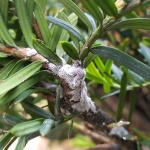 Taxus Mealybug: Dysmicoccus wistariae will produce honeydew and lead to sooty mold growth, yellowing of needles, and sparsely foliated plants. Eventual dieback may be possible. This species is commonly associated with taxus in New England, but can be occasionally found on dogwood, rhododendron, Prunus spp., maple, andromeda, and crabapple. These mealybugs are found on stems and branches and particularly like to congregate at branch crotches. Taxus mealybug feeds in the inner bark tissue of the trunk and branches. Adult females are present from June to August and give birth to living young in the summer. Immatures overwinter. A single generation may occur per year in New England, but areas to the south can have multiple generations of this insect. Management may be targeted between 246-618 GDD’s, base 50°F. Horticultural oil and neem oil may be used.
Taxus Mealybug: Dysmicoccus wistariae will produce honeydew and lead to sooty mold growth, yellowing of needles, and sparsely foliated plants. Eventual dieback may be possible. This species is commonly associated with taxus in New England, but can be occasionally found on dogwood, rhododendron, Prunus spp., maple, andromeda, and crabapple. These mealybugs are found on stems and branches and particularly like to congregate at branch crotches. Taxus mealybug feeds in the inner bark tissue of the trunk and branches. Adult females are present from June to August and give birth to living young in the summer. Immatures overwinter. A single generation may occur per year in New England, but areas to the south can have multiple generations of this insect. Management may be targeted between 246-618 GDD’s, base 50°F. Horticultural oil and neem oil may be used.
- Tuliptree Aphid: Illinoia liriodendri is a species of aphid associated with the tuliptree, wherever it is grown. (They may at times also feed on magnolia, according to reports.) Depending upon local temperatures, these aphids may be present from mid-June through early fall. Large populations can develop by late summer. Some leaves, especially those in the outer canopy, may brown and drop from infested trees prematurely. The most significant impact these aphids can have is typically the resulting honeydew, or sugary excrement, which may be present in excessive amounts and coat leaves and branches, leading to sooty mold growth. This honeydew may also make a mess of anything beneath the tree. Wingless adults are approximately 1/8 inch in length, oval, and can range in color from pale green to yellow. There are several generations per year. This is a native insect. If management is deemed necessary, select options that will preserve natural enemies, as ladybeetles and other beneficial insects are often associated with the tuliptree aphid.
- Twolined Chestnut Borer: Agrilus bilineatus is a native jewel beetle (also known as a flatheaded borer) in the Family Buprestidae. This insect is also in the same genus as the invasive emerald ash borer. The twolined chestnut borer is native to Massachusetts, much of New England, and the eastern United States. This species has one generation per year and adults are typically active from April – August, depending upon location and temperature. Adults will conduct some maturation feeding on oak prior to mating. Females will lay clusters of tiny eggs in the cracks and crevices of bark. Larvae hatch from the eggs in 1-2 weeks and burrow through the bark into the cambium, where they feed in a similar manner to the emerald ash borer, creating meandering galleries as they feed. (The galleries of the twolined chestnut borer can be straight in very stressed trees.) Larvae typically mature by August – October and burrow to the outer bark where they create a chamber in which they overwinter. Pupation occurs the following spring and adults emerge through D-shaped exit holes that are approximately 1/5 inch wide. In the northern extent of this insect’s range, they can take 2 years to complete their life cycle. Larvae of this insect have been recorded from eastern white oak, common post oak, burr oak, scarlet oak, northern red oak, and eastern black oak. Adults have been recorded on fir and pin oak. These insects are attracted to stressed host plants and typically become a secondary factor in the decline of the tree.
- Two-Spotted Spider Mite: Tetranychus urticae is a “warm-season” mite that loves hot and dry weather, which may favor the quick reproduction and build-up of this pest. Management should seek to preserve beneficial predatory mites. Monitor susceptible hosts (elm, maple, redbud, ash, black locust, tuliptree, and many deciduous shrubs) for increasing numbers of these mites until mid-August. Mites will be found on the undersides of leaves and cause stippling of the foliage.
- Viburnum Leaf Beetle: Pyrrhalta viburni is a beetle in the family Chrysomelidae that is native to Europe, but was found in Massachusetts in 2004. This beetle feeds exclusively on many different species of viburnum, which includes, but is not limited to, susceptible plants such as V. dentatum, V. nudum, V. opulus, V. propinquum, and V. rafinesquianum. Some viburnum have been observed to have varying levels of resistance to this insect, including but not limited to V. bodnantense, V. carlesii, V. davidii, V. plicatum, V. rhytidophyllum, V. setigerum, and V. sieboldii. More information about viburnum leaf beetle may be found at http://www.hort.cornell.edu/vlb/ .
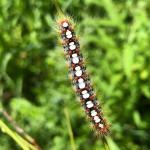
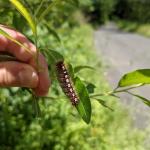

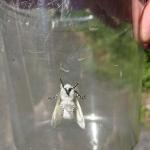
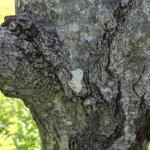
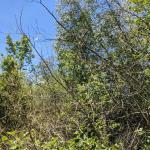
 White Satin Moth: Leucoma salicis was recently reported from Beartown State Forest (Berkshire County) on 6/23/2021 by the Massachusetts Department of Conservation and Recreation, Forest Health Program. This is the same location that caterpillars of this species were seen defoliating their hosts in 2020. Caterpillars, pupae, adult moths, and egg masses were observed at this location on 6/24/2021. Very noticeable predation of the adult moths by birds was also witnessed, along with the aftermath of this predation (remains of white satin moth wings on the ground).
White Satin Moth: Leucoma salicis was recently reported from Beartown State Forest (Berkshire County) on 6/23/2021 by the Massachusetts Department of Conservation and Recreation, Forest Health Program. This is the same location that caterpillars of this species were seen defoliating their hosts in 2020. Caterpillars, pupae, adult moths, and egg masses were observed at this location on 6/24/2021. Very noticeable predation of the adult moths by birds was also witnessed, along with the aftermath of this predation (remains of white satin moth wings on the ground).
The caterpillars of this species have a unique color pattern, which helps us distinguish them from others. The dorsal (back) side of the caterpillar is marked with 10-11 white, intersegmental spots as well as paired, red “setal warts”. The sides of the caterpillars are blueish gray. These caterpillars are known to the edges of waterways, woodlands, and forests from Canada to northwestern Connecticut and central New York. One generation occurs per year with mature caterpillars known in May and June. Host plants include aspen, poplar, and willow and are fed upon by the caterpillars of this species.
The white satin moth was introduced from Europe and first reported between Boston, MA and Hampton, New Hampshire in 1920. This insect is said to overwinter in the third instar (caterpillars pass through seven instars), either individually or in small groups. In the spring time, caterpillars leave their areas of hibernation to feed on nearby leaves. Caterpillars spin a thin cocoon between leaves or between exfoliating or thick bark crevices. Pupae are dark brown/black and often in a thin, loose silken sack. Pupae also sport brightly colored, yellow setae (hairs) that make them quite attractive. Pupation begins by the end of June. Shortly thereafter, moths emerge and females lay egg masses covered in a frothy, white material from July – mid-August. Eggs hatch sometime in August, and larvae will conduct feeding in August and September.
While caterpillars of this species are not noted to be of particular concern with regard to causing allergic reactions such as dermatitis, they are a type of tussock moth and do possess hairs, so they should not be handled/approached with caution particularly by sensitive individuals.
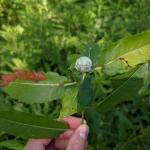 Willow Pinecone Gall Midge: Rhabdophaga strobiloides is in the Family Cecidomyiidae (Gall and Wood Midges) and induces the creation of a splendid and very interesting pinecone shaped gall on willow (Salix spp.). Female midges begin the gall formation when they lay a single egg at the terminal bud of willows in the spring. The female midge injects chemicals into the plant, along with chemicals secreted/exuded by the egg and the larva once the egg hatches, which direct the plant tissues involved to form the shape of a pinecone. Early-season galls are ball-like, such as the one photographed in Berkshire County, MA on 6/24/2021 pictured here. As the growing season progresses, the galls become cone-shaped. The single midge fly larva develops inside the center of the gall. Pupation will occur next spring, with adults emerging from the top of the gall, who will give rise to next year’s population. These insects cause little to no damage to the overall health of their host plants. In fact, multiple entomologists agree that they add ornamental value and interest!
Willow Pinecone Gall Midge: Rhabdophaga strobiloides is in the Family Cecidomyiidae (Gall and Wood Midges) and induces the creation of a splendid and very interesting pinecone shaped gall on willow (Salix spp.). Female midges begin the gall formation when they lay a single egg at the terminal bud of willows in the spring. The female midge injects chemicals into the plant, along with chemicals secreted/exuded by the egg and the larva once the egg hatches, which direct the plant tissues involved to form the shape of a pinecone. Early-season galls are ball-like, such as the one photographed in Berkshire County, MA on 6/24/2021 pictured here. As the growing season progresses, the galls become cone-shaped. The single midge fly larva develops inside the center of the gall. Pupation will occur next spring, with adults emerging from the top of the gall, who will give rise to next year’s population. These insects cause little to no damage to the overall health of their host plants. In fact, multiple entomologists agree that they add ornamental value and interest!
Concerned that you may have found an invasive insect or suspicious damage caused by one? Need to report a pest sighting? If so, please visit the Massachusetts Introduced Pests Outreach Project: http://massnrc.org/pests/pestreports.htm .
Reported by Tawny Simisky, Extension Entomologist, UMass Extension Landscape, Nursery, & Urban Forestry Program
Additional Resources
Pesticide License Exams - The MA Dept. of Agricultural Resources (MDAR) is now holding exams online. For more information and how to register, go to: https://www.mass.gov/pesticide-examination-and-licensing.
To receive immediate notification when the next Landscape Message update is posted, join our e-mail list or follow us on Facebook.
For a complete listing of upcoming events, see our upcoming educational events https://ag.umass.edu/landscape/upcoming-events
For commercial growers of greenhouse crops and flowers - Check out UMass Extension's Greenhouse Update website
For professional turf managers - Check out Turf Management Updates
For home gardeners and garden retailers - Check out our home lawn and garden resources.
Diagnostic Services
UMass Laboratory Diagnoses Landscape and Turf Problems - The UMass Extension Plant Diagnostic Lab is available to serve commercial landscape contractors, turf managers, arborists, nurseries and other green industry professionals. It provides woody plant and turf disease analysis, woody plant and turf insect identification, turfgrass identification, weed identification, and offers a report of pest management strategies that are research based, economically sound and environmentally appropriate for the situation. Accurate diagnosis for a turf or landscape problem can often eliminate or reduce the need for pesticide use. For sampling procedures, detailed submission instructions and a list of fees, see Plant Diagnostic Laboratory
Soil and Plant Nutrient Testing - The University of Massachusetts Soil and Plant Nutrient Testing Laboratory is located on the campus of The University of Massachusetts at Amherst. Testing services are available to all. The lab provides test results and recommendations that lead to the wise and economical use of soils and soil amendments. For more information, visit the UMass Soil and Plant Nutrient Testing Laboratory web site. Routine soil analysis and particle size analysis ONLY (no other types of soil analyses available at this time). Turnaround time: Please plan for the fact that date of receipt in the lab is affected by weekends, holidays, shipping time, and time for UMass Campus Mail to deliver samples to the lab. Campus Mail delivery only takes place on Monday, Wednesday, and Friday due to pandemic restrictions.
Tick Testing - The UMass Center for Agriculture, Food, and the Environment provides a list of potential tick identification and testing options at: https://ag.umass.edu/resources/tick-testing-resources.
